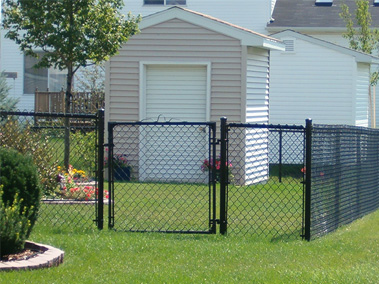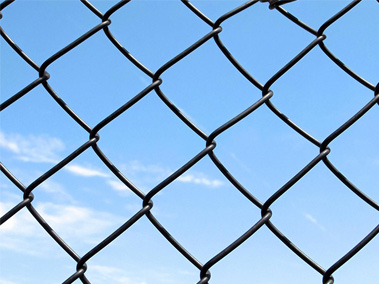

Choose your chain link fencing fabric based on three criteria: gauge, mesh size and type of protective coating.
The gauge or diameter of the wire is one of the most important factors - it helps to tell you how much steel is actually contained in the chain link fabric. The smaller the gauge number, the more steel, the higher the quality and the stronger the wire. From the lightest to the heaviest, common gauges for chain link fencing are 13, 12-1/2, 11-1/2, 11, 9 and 6. Unless you are building a temporary chain link fence, we recommend that your chain link fence is between 11 and 9. 6 is usually used for heavy industrial or professional use, and 11 is a heavy-duty residential chain link and is more suitable for children and pets.

Chain Link Fence
The grid size tells you how far apart the parallel lines are in the grid. This is another indication of how much steel is in the links. The smaller the diamond, the more steel there is in the chain link fabric. From largest to smallest, typical link grid sizes are 2-3/8", 2-1/4" and 2". Smaller chain link meshes such as 1-3/4" for tennis courts and 1-1/4" for swimming pools and higher security are also available in 5/8", 1/2" and 3/8" mini-chain link meshes.
Several types of finishes help to protect, beautify and enhance the appearance of steel chain link fabrics.
The most common protective coating for link fabrics is zinc. Zinc is a self-sacrificing element. In other words, it dissipates as it protects the steel. It also provides cathodic protection, which means that if the wire is cut, it "repairs" the exposed surface by forming a white oxide layer that prevents red rust. Typically, galvanised chain link fabric has a coating of 1.2 ounces per square foot. For specification items requiring longer life, a 2 oz zinc coating may be used. The life of the protective coating is directly related to the amount of zinc used.
Chain Link Fence
There are two main ways to galvanise (galvanise) chain link fabric. The most common is Galvanised After Weaving (GAW), where the wire is first formed into a link fabric and then galvanised. The other method is galvanised before weaving (GBW), in which the wire strands are galvanised before they are formed into a web. There is some debate as to which is the best method.GAW ensures that all wire is coated, even the cut ends, and galvanising the wire after formation also tends to increase the tensile strength of the finished product.GAW is often the preferred method for larger manufacturers as it requires a higher level of manufacturing expertise and capital investment than simple woven wire, and it produces efficiencies that can only be obtained by this method. GBW is a good product, provided it is available in diamond size.
You can also find aluminium-plated (aluminised) chain link wire on the market. Aluminium differs from zinc in that it is a barrier coating rather than a sacrificial coating, so cut ends, scratches or other defects tend to produce red rust in a relatively short period of time. Aluminium plating is best suited where aesthetics are less important than structural integrity. Another type of metal coating sold under various trade names uses a combination of zinc and aluminium, combining the cathodic protection of zinc with the barrier protection of aluminium.

Chain Link Fence
4. Want colour? Look for polyvinyl chloride in addition to the zinc coating on the chain link. This provides a second type of corrosion protection and blends aesthetically with the environment. These coloured coatings are applied using three main coating methods.
Extruded-Vinyl sheathing contains a steel core - suitable for most residential/light commercial applications.
Extrusion bonding - an adhesive bonds the vinyl sheathing to the core.
Hot fusion - the vinyl coating is fused to a galvanised steel core - suitable for all applications.
Make sure you know the specification of the finished product and the steel core wire. Produced in 11 gauge finished diameter, which in most coating processes means the steel core is very light - not recommended for normal installation of 1-3/4" to 2-38" diamond size mesh.
